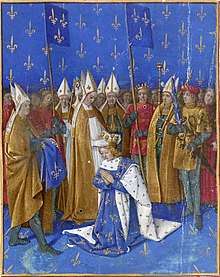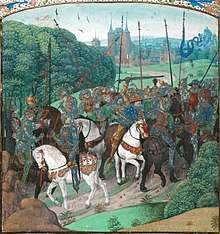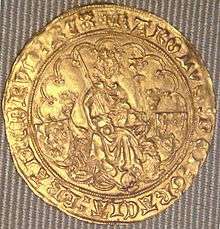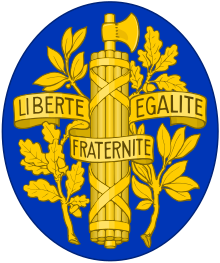Charles VI of France
Charles VI (3 December 1368 – 21 October 1422), called the Beloved (French: le Bien-Aimé) and later the Mad (French: le Fol or le Fou), was King of France for 42 years, from 1380 until his death in 1422. He is known for his mental illness and psychotic episodes which plagued him throughout his life. Charles's reign would see his army crushed at the Battle of Agincourt, leading to the signing of the Treaty of Troyes, which made his future son-in-law Henry V of England his regent and heir to the throne of France. However, Henry would die shortly before Charles, which gave the House of Valois the chance to continue the fight against the English, leading to their eventual victory and the end of the Hundred Years' War in 1453.
| Charles VI the Beloved | |
|---|---|
 Charles VI by the painter known as the Master of Boucicaut (1412) | |
| King of France | |
| Reign | 16 September 1380 – 21 October 1422 |
| Coronation | 4 November 1380 |
| Predecessor | Charles V |
| Successor | Charles VII[1] |
| Regents | |
| Born | 3 December 1368 Paris, Kingdom of France |
| Died | 21 October 1422 (aged 53) Paris, Kingdom of France |
| Burial | 11 November 1422 Saint Denis Basilica |
| Spouse | |
| Issue among others... | |
| House | Valois |
| Father | Charles V of France |
| Mother | Joan of Bourbon |
Early life
Charles was born in Paris, in the royal residence of the Hôtel Saint-Pol, on 3 December 1368, the son of the king of France Charles V, of the House of Valois, and of Joan of Bourbon. As heir to the French throne, his elder brothers having died before he was born, Charles held the title Dauphin of France.
King of France
Regency
At his father's death on 16 September 1380, he inherited the throne of France. His coronation took place on 4 November 1380, at Reims Cathedral.[2] Charles VI was only 11 years old when he was crowned King of France. During his minority, France was ruled by Charles' uncles, as regents. Although the royal age of majority was 14 (the "age of accountability" under Roman Catholic canon law), Charles terminated the regency only at the age of 21.
The regents were Philip the Bold, Duke of Burgundy, Louis I, Duke of Anjou, and John, Duke of Berry – all brothers of Charles V – along with Louis II, Duke of Bourbon, Charles VI's maternal uncle. Philip took the dominant role during the regency. Louis of Anjou was fighting for his claim to the Kingdom of Naples after 1382, dying in 1384; John of Berry was interested mainly in the Languedoc,[3] and not particularly interested in politics; and Louis of Bourbon was a largely unimportant figure, owing to his personality (showing signs of mental instability) and status (since he was not the son of a king).
During the rule of his uncles, the financial resources of the kingdom, painstakingly built up by his father, were squandered for the personal profit of the dukes, whose interests were frequently divergent or even opposing. During that time, the power of the royal administration was strengthened and taxes re-established. The latter policy represented a reversal of the deathbed decision of the king's father Charles V to repeal taxes, and led to tax revolts, known as the Harelle. Increased tax revenues were needed to support the self-serving policies of the king's uncles, whose interests were frequently in conflict with those of the crown and with each other. The Battle of Roosebeke (1382), for example, brilliantly won by the royal troops, was prosecuted solely for the benefit of Philip of Burgundy. The treasury surplus carefully accumulated by Charles V was quickly squandered.
Charles VI brought the regency to an end in 1388, taking up personal rule. He restored to power the highly competent advisors of Charles V, known as the Marmousets,[4] who ushered in a new period of high esteem for the crown. Charles VI was widely referred to as Charles the Beloved by his subjects.


Reign
Mental illness

Charles VI's early successes with the Marmousets as his counselors quickly dissipated as a result of the bouts of psychosis he experienced from his mid-twenties. Mental illness may have been passed on for several generations through his mother, Joanna of Bourbon.[5] Although still called by his subjects Charles the Beloved, he became known also as Charles the Mad.
Charles's first known episode occurred in 1392 when his friend and advisor, Olivier de Clisson, was the victim of an attempted murder. Although Clisson survived, Charles was determined to punish the would-be assassin, Pierre de Craon, who had taken refuge in Brittany. John V, Duke of Brittany, was unwilling to hand him over, so Charles prepared a military expedition.
Contemporaries said Charles appeared to be in a "fever" to begin the campaign and disconnected in his speech. Charles set off with an army on 1 July 1392. The progress of the army was slow, driving Charles into a frenzy of impatience. As the king and his escort were traveling through the forest near Le Mans on a hot August morning, a barefoot leper dressed in rags rushed up to the King's horse and grabbed his bridle. "Ride no further, noble King!" he yelled: "Turn back! You are betrayed!" The king's escorts beat the man back, but did not arrest him, and he followed the procession for half an hour, repeating his cries.[6] The company emerged from the forest at noon. A page who was drowsy from the sun dropped the king's lance, which clanged loudly against a steel helmet carried by another page. Charles shuddered, drew his sword and yelled "Forward against the traitors! They wish to deliver me to the enemy!" The king spurred his horse and began swinging his sword at his companions, fighting until one of his chamberlains and a group of soldiers were able to grab him from his mount and lay him on the ground. He lay still and did not react, but then fell into a coma. The king had killed a knight known as "The Bastard of Polignac" and several other men.[7]
Periods of mental illness continued throughout the king's life. During one in 1393, he could not remember his name and did not know he was king. When his wife came to visit, he asked his servants who she was and ordered them to take care of what she required so that she would leave him alone.[8] During an episode in 1395–96 he claimed he was Saint George and that his coat of arms was a lion with a sword thrust through it.[9] At this time, he recognized all the officers of his household, but did not know his wife nor his children. Sometimes he ran wildly through the corridors of his Parisian residence, the Hôtel Saint-Pol, and to keep him inside, the entrances were walled up. In 1405, he refused to bathe or change his clothes for five months.[10] His later psychotic episodes were not described in detail, perhaps because of the similarity of his behavior and delusions. Pope Pius II, who was born during the reign of Charles VI, wrote in his Commentaries that there were times when Charles thought that he was made of glass, and thus tried to protect himself in various ways so that he would not break. He reportedly had iron rods sewn into his clothes so that he would not shatter if he came into contact with another person.[11] This condition has come to be known as glass delusion.
Charles VI's secretary, Pierre Salmon, spent much time in discussions with the king while he was intermittently psychotic. In an effort to find a cure for the king's illness, stabilize the turbulent political situation, and secure his own future, Salmon supervised the production of two distinct versions of the beautifully illuminated guidebooks to good kingship known as Pierre Salmon's Dialogues.[12]
Bal des Ardents

On 29 January 1393, a masked ball, which later became known as the Bal des Ardents ("Ball of the Burning Men"), had been organized by Isabeau of Bavaria to celebrate the wedding of one of her ladies-in-waiting at the Hôtel Saint-Pol. At the suggestion of Huguet de Guisay, the king and four other lords[13] dressed up as wild men and they were dancing around. They were dressed "in costumes of linen cloth sewn onto their bodies and soaked in resinous wax or pitch to hold a covering of frazzled hemp, so that they appeared shaggy & hairy from head to foot".[14] At the suggestion of one Yvain de Foix, the king commanded that the torch-bearers were to stand at the side of the room. Nonetheless, the king's brother Louis I, Duke of Orléans, who had arrived late, approached with a lighted torch in order to discover the identity of the masqueraders, and accidentally set one of them on fire. There was panic as the flames spread. The Duchess of Berry threw the train of her gown over the king in order to protect him.[15] Several knights who tried to put out the flames were severely burned. Four of the wild men perished: Charles de Poitiers, son of the Count of Valentinois; Huguet de Guisay; Yvain de Foix; and the Count of Joigny. Another – Jean, son of the Lord of Nantouillet – saved himself by jumping into a dishwater tub.[16]
Expulsion of the Jews, 1394
On 17 September 1394, Charles suddenly published an ordinance in which he declared, in substance, that for a long time he had been taking note of the many complaints provoked by the excesses and misdemeanors of the Jews against Christians, and that the prosecutors had made several investigations and discovered that the Jews broke the agreement with the king on many occasions. Therefore, he decreed, as an irrevocable law and statute, that no Jew should dwell in his domains ("Ordonnances", vii. 675). According to the Religieux de St. Denis, the king signed this decree at the insistence of the queen ("Chron. de Charles VI." ii. 119).[17] The decree was not immediately enforced, a respite being granted to the Jews in order that they have enough time to sell their property and pay their debts. Those indebted to them were enjoined to redeem their obligations within a set time; otherwise their pledges held in pawn were to be sold by the Jews. The provost was to escort the Jews to the frontier of the kingdom. Subsequently, the king released Christians from their debts.
Struggles for power
| French Monarchy |
| Capetian Dynasty (House of Valois) |
|---|
.svg.png) |
| Philip VI |
|
| John II |
| Charles V |
|
| Charles VI |
| Charles VII |
|
| Louis XI |
|
| Charles VIII |
With Charles VI mentally ill, from 1393 his wife Isabeau presided over a regency counsel, on which sat the grandees of the kingdom. Philip the Bold, Duke of Burgundy, who acted as regent during the king's minority (from 1380 to 1388), was a great influence on the queen (he had organized the royal marriage during his regency). Influence progressively shifted to Louis I, Duke of Orléans, the king's brother, another contender for power, and it was suspected, the queen's lover.[18] Charles VI's other uncles were less influential during the regency: Louis II of Naples was still engaged managing the Kingdom of Naples, and John, Duke of Berry, served as a mediator between the Orléans party (what would become the Armagnacs) and the Burgundy party (Bourguignons). The rivalry would increase bit by bit and in the end result in outright civil war.
The new regents dismissed the various advisers and officials Charles had appointed. On the death of Philip the Bold in April 1404, his son John the Fearless took over the political aims of his father, and the feud with Louis escalated. John, who was less linked to Isabeau, again lost influence at court.
Wars with Burgundy and England
In 1407, Louis of Orléans was murdered in the rue Vieille du Temple in Paris. John did not deny responsibility, claiming that Louis was a tyrant who squandered money. Louis' son Charles, the new Duke of Orléans, turned to his father-in-law, Bernard VII, Count of Armagnac, for support against John the Fearless. This resulted in the Armagnac-Burgundian Civil War, which lasted from 1407 until 1435, beyond Charles' reign, though the war with the English was still in progress.
With the English taking over much of the country, John the Fearless sought to end the feud with the royal family by negotiating with the Dauphin Charles, the king's heir. They met at the bridge at Montereau on 10 September 1419, but during the meeting, John was killed by Tanneguy du Chastel, a follower of the Dauphin. John's successor, Philip the Good, the new Duke of Burgundy, threw in his lot with the English.
English invasion and death
Charles VI's reign was marked by the continuing conflict with the English, known as the Hundred Years' War. An early attempt at peace occurred in 1396 when Charles' daughter, the almost seven-year-old Isabella of Valois, married the 29-year-old Richard II of England. By 1415, however, the feud between the French royal family and the House of Burgundy led to chaos and anarchy throughout France, a situation that Henry V of England was eager to take advantage of. Henry led an invasion that culminated in the defeat of the French army at the Battle of Agincourt in October.
In May 1420, Henry V and Charles VI signed the Treaty of Troyes, which named Henry as Charles' successor, and stipulated that Henry's heirs would succeed him on the throne of France. It disinherited the Dauphin Charles, then only 17 years old. (In 1421, it was implied in Burgundian propaganda that the young Charles was illegitimate.) The treaty also betrothed Charles VI's daughter, Catherine of Valois, to Henry (see English Kings of France). Disinheriting the Dauphin in favor of Henry was a blatant act against the interests of the French aristocracy, supported by the Duke of Burgundy.
The Dauphin who had declared himself regent for his father when the Duke of Burgundy invaded Paris and captured the king, had established a court at Bourges.[19]
Charles VI died on 21 October 1422 in Paris, at the Hôtel Saint-Pol. He was interred in Saint Denis Basilica, where his wife Isabeau of Bavaria would join him after her death in September 1435.
Henry V had died in August 1422, leaving an infant son, who became King Henry VI of England. Therefore, according to the Treaty of Troyes, with the death of Charles VI, little Henry became King of France. His coronation as such was in Paris (held by the English since 1418) at the cathedral of Notre Dame de Paris on 26 December 1431.
The son disinherited by Charles VI, the Dauphin Charles, continued to fight to regain his kingdom. In 1429 Joan of Arc arrived on the scene. She led his forces to victory against the English, and took him to be crowned in Reims Cathedral as King Charles VII of France on 17 July 1429. He became known as "Charles the Victorious" and was able to restore the French line to the throne of France by defeating the English in 1450.[20]
Marriage and issue
Charles VI married Isabeau of Bavaria (ca. 1371 – 24 September 1435) on 17 July 1385. She gave birth to 12 children:
| Name | Birth | Death | Notes |
|---|---|---|---|
| Charles, Dauphin of Viennois | 25 September 1386 | 28 December 1386 | Died young. First Dauphin. |
| Jeanne | 14 June 1388 | 1390 | Died young. |
| Isabella | 9 November 1389 | 13 September 1409 | Married (1) Richard II, King of England, in 1396. No issue.[21] Married (2) Charles, Duke of Orléans, in 1406. Had issue. |
| Jeanne | 24 January 1391 | 27 September 1433 | Married John V, Duke of Brittany, in 1396. Had issue. |
| Charles, Dauphin of Viennois | 6 February 1392 | 13 January 1401 | Died young. Second Dauphin. Engaged to Margaret of Burgundy after his birth. |
| Marie | 22 August 1393 | 19 August 1438 | Never married – became an abbess. No issue. Died of the Plague |
| Michelle | 11 January 1395 | 8 July 1422 | Married Philip the Good, Duke of Burgundy, in 1409.[22] Had no surviving issue. |
| Louis, Dauphin | 22 January 1397 | 18 December 1415 | Married Margaret of Burgundy. No issue. Third Dauphin. |
| John, Dauphin | 31 August 1398 | 5 April 1417 | Married Jacqueline, Countess of Hainaut, in 1415. No issue. Fourth Dauphin. |
| Catherine | 27 October 1401 | 3 January 1437 | Married (1) Henry V, King of England, in 1420. Had issue. Married (?) (2) Owen Tudor. Had issue. |
| Charles, Dauphin of Viennois | 22 February 1403 | 21 July 1461 | The fifth Dauphin became Charles VII, King of France, after his father's death. Married Marie of Anjou in 1422. Had issue. |
| Philip | 10 November 1407 | November 1407 | Died young. |
He also had one illegitimate child by Odette de Champdivers: Marguerite, bâtarde de France (d. ca.1458).

Cultural references
- Christine de Pizan dedicates a poem to Charles VI Prière pour le roi Charles in which she pleas for the health of her king.
- The Romantic French poet Gérard de Nerval wrote a poem dedicated to the king: "Rêverie de Charles VI".[23]
- The novel The Notebooks of Malte Laurids Brigge by Rainer Maria Rilke describes the old age of Charles VI at length.
- King Charles VI, and his madness, are mentioned at length in the historical novel In a Dark Wood Wandering (1949) by Hella S. Haasse.
- Charles VI is a character in William Shakespeare's Henry V, as "King of France".
See also
References
Citations
- or Henry VI of England (disputed)
- Jonathan Sumption, The Hundred Years War: Divided Houses, Vol. III, (University of Pennsylvania Press, 2009), 397.
- Vaughan, 40–41
- Vaughn, 42.
- Alger, Sarah (2001). The Politics of Madness: Government in the Reigns of Charles VI and Henry VI (PDF). p. 24.
- W. H. Jervis, A History of France: from the Earliest Times to the Fall of the Second Empire in 1870, (London: John Murray, 1884), 228, §5; Jean Juvenal des Ursins, Histoire de Charles VI, Roy de France, (Paris: A. Desrez, 1841), 377; Michaud, J. F and L. G., Biographie universelle, ancienne et moderne, 85 vols., (Paris: L. G. Michaud, 1813), 8:114 sub Charles VI.
- M. Guizot, The History of France from the Earliest Times to the Year 1789, Vol. 2, transl. Robert Black, (P. F. Collier & son, 1902), 189.
- R. C. Famiglietti, Royal Intrigue: Crisis at the Court of Charles VI, 1392–1420, New York, 1986, p. 4, citing the chronicle of the Religieux de Saint-Denis, ed. Bellaguet, II, pp. 86–88.
- R. C. Famiglietti, Royal Intrigue: Crisis at the Court of Charles VI, 1392–1420, New York, 1986, p. 5, citing the chronicle of the Religieux de Saint-Denis, ed. Bellaguet, II, pp. 404–05.
- R. C. Famiglietti, Royal Intrigue: Crisis at the Court of Charles VI, 1392–1420, New York, 1986, p. 6, citing the chronicle of the Religieux de Saint-Denis, ed. Bellaguet, III, p. 348
- Enea Silvio Piccolomini (Papa Pio II), I Commentarii, ed. L. Totaro, Milano, 1984, I, p. 1056.
- "Pierre Salmon's Dialogues – Wikicommons".
- Froissart's Chronicles, ed. T. Johnes, II (1855), p. 550
- Barbara Tuchman, A Distant Mirror, 1978, Alfred A Knopf Ltd. See the chronicle of the Religieux de Saint-Denis, ed. Bellaguet, II, pp. 64–71, where the squire's name is given correctly as de Guisay.
- Froissart's Chronicles, ed. T. Johnes, II (1855), pp. 550–2
- Froissart's Chronicles, ed. T. Johnes, II (1855), p. 550. Note that Froissart and the Religieux de Saint-Denis differ as to when the four men died. Huguet de Guisay had held the office of cupbearer of the king.
- History of the reign of Charles VI, titled Chronique de Religieux de Saint-Denys, contenant le regne de Charles VI de 1380 a 1422, encompasses the king's full reign in six volumes. Originally written in Latin, the work was translated to French in six volumes by L. Bellaguet between 1839 and 1852.
- Alban Dignat, 23 novembre 1407: Assassinat dans la rue Vieille du Temple, herodote.net Archived 11 December 2006 at the Wayback Machine
- R.C. Famiglietti, Royal Intrigue: Crisis at the Court of Charles VI, 1392–1420, New York, 1986, Chapter X.
- Chartier, Jean, Chronique de Charles VII, Roi de France, publié avec notes par Vallet de Viriville, Paris 1858
- Jeffrey Hamilton, The Plantagenets: History of a Dynasty, (Continuum, 2010), 205.
- Jonathan Sumption, Cursed Kings: The Hundred Years War IV, (Faber and Faber Ltd., 2015), 103.
- (in French) Gérard de Nerval. Rêverie de Charles VI
Sources
- Famiglietti, R.C., Royal Intrigue: Crisis at the Court of Charles VI, 1392–1420, New York; AMS Press, 1986.
- Famiglietti, R.C., Tales of the Marriage Bed from Medieval France (1300–1500), Providence; Picardy Press, 1992.
- Potter, Philip J., Kings of the Seine: The French Rulers from Pippin III to Jacques Chirac, 2006, PublishAmerica, Baltimore, ISBN 978-1-4137-8857-0.
External links
- "Biography of Charles VI the mad of France (1368–1422)". guusbeltman.nl. Retrieved 6 November 2015.
- Britannica, eds. (20 July 1998). "Charles VI king of France". Encyclopædia Britannica.CS1 maint: extra text: authors list (link) CS1 maint: ref=harv (link)
- "Charles VI". Shakespeareandhistory.com.
- Chisholm, Hugh, ed. (1911), "Charles VI (1368–1422), king of France", Encyclopædia Britannica (11th ed.), 5, Cambridge University Press.
Charles VI of France Cadet branch of the Capetian dynasty Born: 3 December 1368 Died: 21 October 1422 | ||
| Regnal titles | ||
|---|---|---|
| Preceded by Charles V |
King of France 16 September 1380 – 21 October 1422 |
Succeeded by Charles VII contested by Henry II |
| Dauphin of Viennois 3 December 1368 – 26 September 1386 |
Succeeded by Charles III | |
| Preceded by Charles III |
Dauphin of Viennois 28 December 1386 – 6 February 1392 |
Succeeded by Charles IV |
